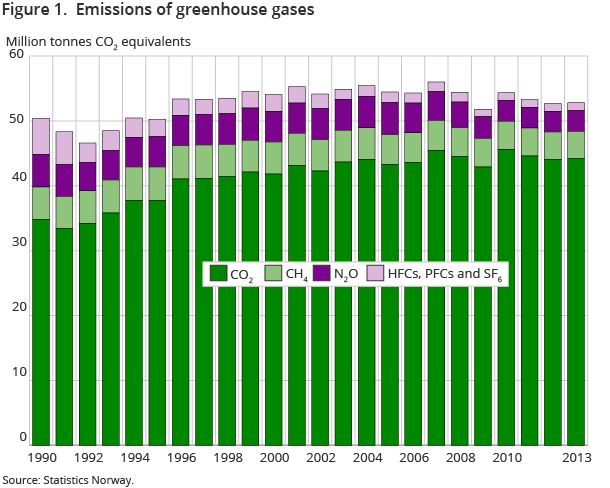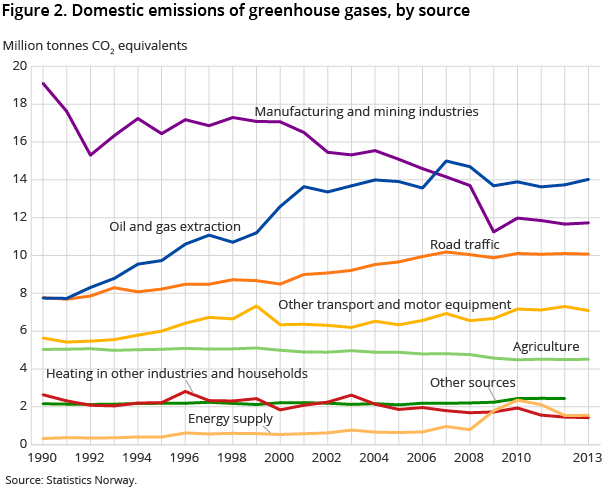Content
Published:
This is an archived release.
Minor change in greenhouse gas emissions
The preliminary figures for 2013 show that greenhouse gas emissions from Norwegian territory totalled 52.8 million tonnes. This is an increase of 0.1 million tonnes or 0.2 per cent compared with 2012.
| 2013 | Change in per cent | ||
|---|---|---|---|
| Since 1990 | 2012 - 2013 | ||
| 1Does not include international sea and air traffic. | |||
| Emissions from Norwegian territory | 52.8 | 4.8 | 0.2 |
| Oil and gas extraction | 14.0 | 81.0 | 2.1 |
| Manufacturing industries and mining | 11.7 | -38.6 | 0.6 |
| Energy supply | 1.6 | 376.9 | 0.8 |
| Heating in other industries and households | 1.4 | -45.9 | -2.0 |
| Road traffic | 10.1 | 29.7 | -0.3 |
| Aviation, navigation, fishing, motor equip. etc. | 7.1 | 25.7 | -3.0 |
| Agriculture | 4.5 | -10.3 | 0.3 |
| Other | 2.4 | 12.8 | -0.1 |


Oil and gas extraction was the main source of greenhouse gas emissions in 2013, with 14 million tonnes of CO2 equivalents , representing 27 per cent of total greenhouse gas emissions. This was an increase of about 2 per cent compared with the previous year. Higher emissions are related to increased consumption of marine fuel due to growth in the number of drilling days both in production fields and exploration fields.
Slight increase in emissions from energy supply
Greenhouse gas emissions from energy supply amounted to 1.5 million tonnes of CO2 equivalents or 2.9 per cent of total emissions in 2013. Emissions rose by 0.7 per cent compared with 2012. The increase was due to higher coal consumption in 2013 than the year before.
Lower heating emissions
Heating emissions amounted to 1.4 million tonnes of CO2 equivalents in 2013. This was almost half of the emissions from this source in 1990 and 2 per cent lower than in 2012. The decline over the past year was due to the reduction in the consumption of fuel oil. This in turn could most likely be explained by a reduced need for heating as 2013 was a relatively warm year. The average temperature for this year was 1 degree above normal, compared to 0.4 degrees above normal in 2012.
Almost unchanged emissions from road traffic
Sales of gasoline fell 6.3 per cent in 2013 but this was largely offset by the increase in sales of diesel. This led to a relatively small decline in the estimated emissions from road traffic. Compared with 2012, emissions from this source decreased by 0.3 per cent to 10 million tonnes of CO2 equivalents. However, this is almost 30 per cent higher than emissions in 1990. The increase in emissions from road traffic is due to a larger number of vehicles and increased mileage. More energy-efficient vehicles and the transition from gasoline to diesel, which results in lower emissions per kilometre, as well as blending of biofuel, have helped to slow the growth.
Reduction in emissions from other transport and motorised equipment
Greenhouse gas emissions from other transportation fell by 3.0 per cent in 2013 compared with the previous year and amounted to 7.1 million tonnes of CO2 equivalents. This represents 13.4 per cent of the total emissions. The share of emissions from other transport has remained stable between 11 and 14 per cent throughout the period 1990-2013. The reduction in emissions since 2012 can be explained by lower consumption of fuel for domestic shipping and fishing.
Preliminary figures
The figures presented in this article are preliminary and will be revised in January / February 2015. The updated release will also include more detailed tables of emissions by source and by industry.
National targets on emission cutsOpen and readClose
In 2008, the majority in the Norwegian parliament entered into an agreement on a national target for emission reductions. The target is that domestic emissions shall not exceed 45-47 million tonnes of CO2 equivalents in 2020. In 2013, the emissions were approximately 6-8 million tonnes above this national target.
International obligations for NorwayOpen and readClose
Norway's obligations under the second Kyoto period (2013-2020) imply that the average annual emissions of greenhouse gases should be limited to 84 per cent of Norwegian emissions in 1990. This is in line with the climate agreement to reduce emissions by 30 per cent by 2020.
This means that Norway must take responsibility for reducing greenhouse gas emissions by about 100 million tonnes of CO2 equivalents in the period 2013-2020, corresponding to 12-13 million tonnes of CO2 equivalents each year. Norway can meet this obligation through three flexible mechanisms: joint implementation, the clean development mechanism and emissions trading.
This page has been discontinued, see Emissions to air, Annually.
Contact
-
Trude Melby Bothner
E-mail: trude.melby.bothner@ssb.no
tel.: (+47) 40 81 14 25
-
Berit Storbråten
E-mail: berit.storbraten@ssb.no
tel.: (+47) 40 81 14 23
